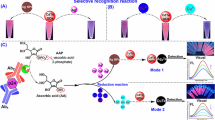Abstract
In this study, anti-Vibrio parahaemolyticus polyclonal and monoclonal antibodies were prepared through intradermal injection immune and lymphocyte hybridoma technique respectively. CdTe quantum dots (QDs) were synthesized at pH 9.3, 98 °C for 1 h with stabilizer of 2.7:1. The fluorescence intensity was 586.499, and the yield was 62.43 %. QD probes were successfully prepared under the optimized conditions of pH 7.4, 37 °C for 1 h, 250 μL of 50 mg/mL EDC · HCl, 150 μL of 4 mg/mL NHS, buffer system of Na2HPO4-citric acid, and 8 μL of 2.48 mg/mL polyclonal antibodies. As gold nanoparticles could quench fluorescence of quantum dots, the concentration of V. parahaemolyticus could be detected through measuring the reduction of fluorescence intensity in immune sandwich reaction composed of quantum dot probe, gold-labeled antibody, and the sample. For pure culture, fluorescence intensity of the system was proportional with logarithm concentration of antigen, and the correlation coefficient was 99.764 %. The fluorescence quenching immunoassay based on quantum dots is established for the first time to detect Vibrio parahaemolyticus. This method may be used as rapid testing procedure due to its high simplicity and sensitivity.






Similar content being viewed by others
References
Su, C. P., Jane, W. N., & Wong, H. C. (2013). International Journal of Food Microbiology, 160, 360–366.
Deepanjali, A., Kumar, H. S., & Karunasagar, I. (2005). Applied and Environmental Microbiology, 71, 3575–3580.
Wang, L., Shi, L., Su, J., Ye, Y., & Zhong, Q. (2013). Gene, 515, 421–425.
Guo, A., Sheng, H. L., Zhang, M., Wu, R. W., & Xie, J. (2012). Journal of Food Quality, 35, 366–371.
Di Pinto, A., Terio, V., Di Pinto, P., Colao, V., & Tantillo, G. (2012). Letters in Applied Microbiology, 54, 494–498.
Kawatsu, K., Ishibashi, M., & Tsukamoto, T. (2006). Journal of Clinical Microbiology, 44, 1821–1827.
Bailey, R. E., Smith, A. M., & Nie, S. (2004). Low-dimensional Systems and Nanostructures, 25, 1–12.
Huang, D., Niu, C., Wang, X., Lv, X., & Zeng, G. (2013). Analytical Chemistry, 85, 1164–1170.
Liu, Y., Liu, C. Y., & Zhang, Z. Y. (2012). Applied Surface Science, 263, 481–485.
Negi, D. P. S., & Chanu, T. I. (2008). Nanotechnology, 19, 465503.
Zhang, M., Cao, X., Li, H., Guan, F., Guo, J., Shen, F., et al. (2012). Food Chemistry, 135, 1894–1900.
Kamat, P. V., Barazzouk, S., & Hotchandani, S. (2002). Angewandte Chemie-International Edition, 41, 2764.
Mandal, G., Bardhan, M., & Ganguly, T. (2011). Journal of Physical Chemistry C, 115, 20840–20848.
Shang, L., & Dong, S. (2009). Analytical Chemistry, 81, 1465–1470.
Hui, Y. (2008). Master thesis, Jilin University, Changchun, China.
DiScipio, R. G. (1996). Analytical Biochemistry, 236, 168–170.
Li, G. A. (2006). Journal of Shaanxi Normal University (Natural Science Edition), 34, 32–35.
Acknowledgments
The research was supported by the Fundamental Research Funds for the Central Universities (NO.2013PY104).
Author information
Authors and Affiliations
Corresponding author
Additional information
Ling Wang and Junxian Zhang contributed equally to this paper.
Rights and permissions
About this article
Cite this article
Wang, L., Zhang, J., Bai, H. et al. Specific Detection of Vibrio Parahaemolyticus by Fluorescence Quenching Immunoassay Based on Quantum Dots. Appl Biochem Biotechnol 173, 1073–1082 (2014). https://doi.org/10.1007/s12010-014-0904-4
Received:
Accepted:
Published:
Issue Date:
DOI: https://doi.org/10.1007/s12010-014-0904-4




